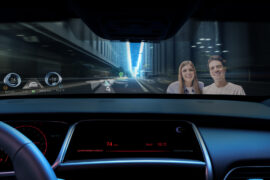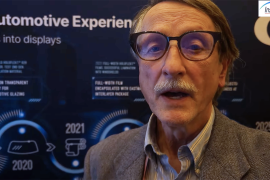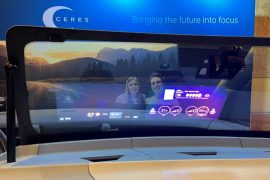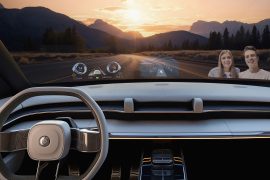Automotive
Ceres Holographics Gains Momentum in Growing HUD MarketCeres Holographics Gains Momentum in Growing HUD Market
23 February 2023
Scottish firm Ceres Holographics, which has developed unique holographic thin-film technology to support transparent windshield displays in automobiles, has received funding from government agency Innovate UK. The Innovate UK grant, which is worth around $350,000, will be used to develop a custom test system for Ceres’ “HoloFlekt” holographic optical elements (HOEs) as the Livingston-based company seeks to commercialize the technology for head-up displays (HUDs) in cars.
Ceres’ unique expertise is in programming and mastering highly precise holographic designs onto photopolymer film, allowing it to function as a transparent projector screen, and then using digital printing technology to replicate those designs for mass production. The company initially explored a variety of holographic applications, including augmented-reality (AR) wearables. But Ceres has focused squarely on the automotive market in recent years, given the interest from automotive original equipment manufacturers (OEMs) in using HUDs to present driving data and other information on the windshield without requiring drivers to look down at traditional gauges or dashboard displays.
Since its founding in 2009, Ceres has raised 7.7 million pound sterling, or USD $9.3 million, from private investors. It has received around $3 million in grants, including a $1.5 million grant in 2019 under the European Commission’s Horizon 2020: Research & Innovation Program. The company also has accrued revenues of $5 million over the last three years doing early design work for automobile manufacturers.
There are several ways to create a HUD in a car’s windshield. One, commercialized by Nippon Seiki, is to put the information on a small display, like an LCD, hidden within a car’s dashboard and then use a series of mirrors to present it as a false image on the windshield. Another, recently developed by Continental AG, is to place a specially coated, black-printed area in a narrow strip along the bottom of the windshield onto which the information from a display mounted flat on top of the dashboard can be reflected.
Ceres’ approach involves installing its HoloFlekt film in the windshield itself—in the plastic “interlayer” that sits between two layers of glass in a laminated windshield—and then using a small projector mounted inside the dashboard to transmit light to the film and render a hologram within the driver’s eyebox (Fig. 1). To create an optical function in the photopolymer film, Ceres uses a digital printer it developed in-house to program the film to be a high-precision diffuser, effectively creating a transparent projection screen within the windshield.
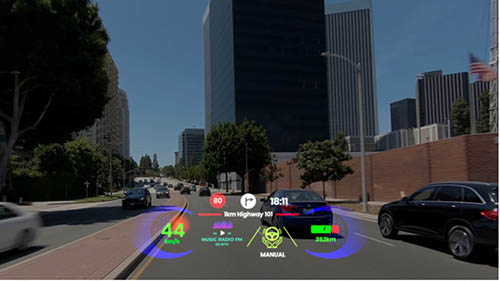
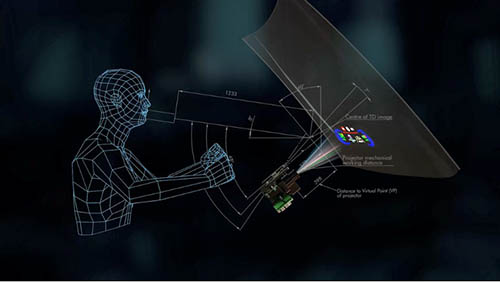
“Imagine a diffuser like a cinema screen, where a cinema screen is optimized to reflect light—the maximum possible—back to the audience in the cinema, but the light goes everywhere,” explained Ceres CEO Andy Travers. “What we’re doing is printing a transparent projection screen that is highly wavelength-tuned to the light that is being projected onto it. So for the red, green, and blue diodes of a laser projector or an LED projector, we match those wavelengths in that projector by programming the hologram—the tiny diffusers in the hologram—to be very receptive to that wavelength and then redirect the light back to the eyebox of the driver. So you can display whatever you want on the screen.”
Ceres uses its software to custom-design an HOE for each automotive model, working on a pixel-by-pixel basis to account for both the curve and rake of a particular windshield and the varying angles of light going to the film and then back to the driver’s eyeballs. What makes the design particularly challenging is that most automobile windshields curve in two directions, both horizontally and vertically, and the curvature often increases on the edges near the pillars. Ceres charges the OEM a non-recurring engineering fee for creating a design, and generally takes two to three months to deliver a proof-of-concept.
“We take in a CAD model of the windshield, and we define the origin point of the projector, and then we computationally map what every pixel has to do depending on the angle at which the light hits the film,” said Travers.
At CES 2023, Ceres demonstrated holograms using a full-RGB digital light processing (DLP) projector from Texas Instruments, which Ceres has been working with for several years. But Travers says it is the OEM’s decision on what type of projector they want and how many colors they want to display, specifications that Ceres can match through its software design tools.
While Ceres works with windshield-size pieces of Bayfol HX film from German supplier Covestro, it programs only a small area to serve as an HOE in the exact place where it aligns with the projector in the dashboard. At 16 pixels per square millimeter, the digital mastering process programs almost one million pixels into an area the size of “A4” European paper (210 × 297 mm, or roughly 8.5 × 11 inches). This is the display size Ceres has been working on the most, but its printer can produce master holograms in sizes ranging from a few square cm up to A2 sheet size (420 × 594 mm).
Once Ceres has created a master HOE, it then can be replicated with a large roll-to-roll production machine at a speed almost 6,000 times faster than the digital mastering process (Fig. 2). Ceres has a custom-built replication machine at its headquarters and has ordered two more to fulfill preproduction volumes. The machine works with rolls of blank film that are 1.2 meters high by 500 meters long, with each roll yielding roughly 250 windshield-sized (1 × 2 m) pieces of HoloFlekt.
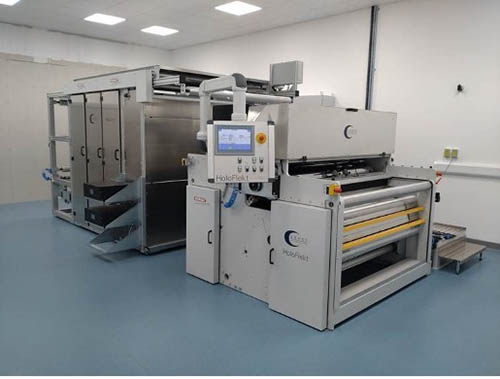
A key partner in Ceres’ CES demonstration was US firm Eastman Chemical, which has figured out how to integrate HoloFlekt into the interlayer product it sells to automobile manufacturers. (Fig. 3). Ceres has been working with Eastman on its most advanced commercial contract with an OEM (it is in early stages with three more OEMs).
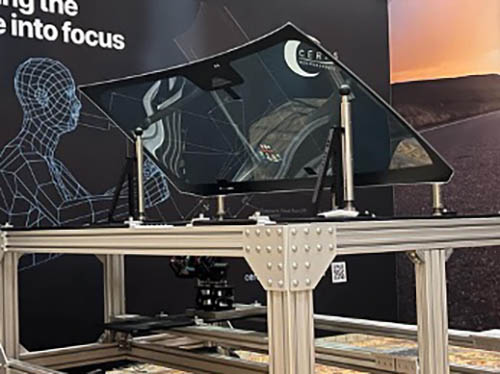
If that automaker goes into mass production, Ceres would sell Eastman the necessary replication machines and also charge it a “tooling supply” fee for each HOE master. Travers expects that Eastman could have 25 of the replication machines at its Massachusetts factory by 2026 or 2027.
Ceres’ business model is to sell printing machines with fees for HOE masters with some licensing revenue as well. Travers said the OEM that Ceres is working with aims to include Holoflekt as a standard feature in its cars, which would leverage the volume and could make this option much more affordable than current HUD solutions that sell for as much as $1,200 to $1,500 extra. But when those revenues might start coming in is unclear.
“We’re absolutely limited by the almost unmovable design cycle of automotive OEMs,” said Travers. “At the moment, we’re talking 2026.”
